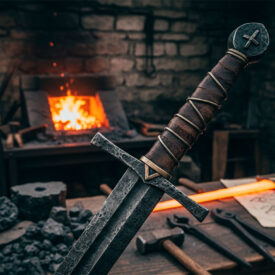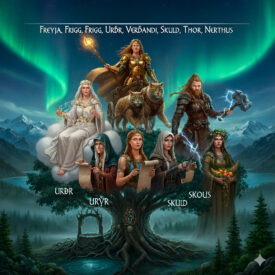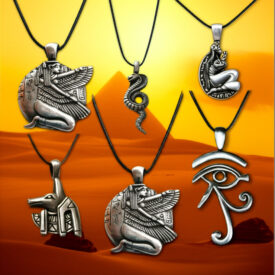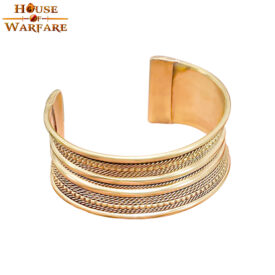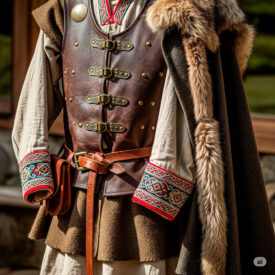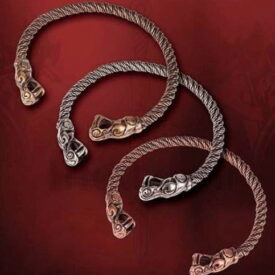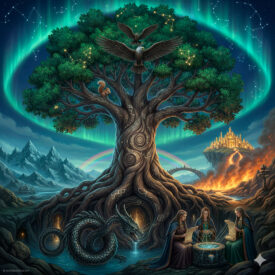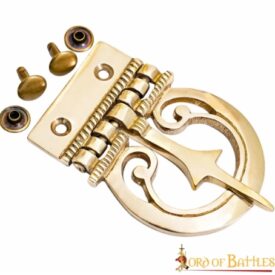Have you ever wondered what secrets the ancient Norse warriors kept in their jewelry? Viking pendants, much more than simple ornaments, were powerful talismans that wove the destiny of their wearers. Each meticulously crafted piece told a story of gods, battles, and a deep connection to the cosmos. In this complete guide, we will unveil the fascinating symbolism behind each Viking pendant, delving into the rich mythology and beliefs of a civilization that forged its legacy with steel and spirit.
Viking Jewelry: Chronological Evolution and Symbolism of Pendants
Viking jewelry (8th–12th centuries) functioned as adornment, status symbol, religious amulet, and means of payment. Its motifs, inspired by beliefs and myths, sought to attract luck, strength, and wisdom. The following table presents a general chronology of pendant motifs and their symbolism according to when they became popular or were consolidated as amulets.
| Era | Event / Symbol and symbolism |
|---|---|
| 8th – 10th Centuries: Early Symbolism and Animal Motifs | |
| Initial artistic styles | Broa-Oseberg art (second half of 8th–mid-9th century) and Borre style (9th–second half of 10th century): strong zoomorphic presence in jewelry; stylized representation of animals and interlace. |
| Representations of gods in animal form |
|
| Yggdrasil (World Tree) | Central cosmological symbol: interconnectedness of all things and the cyclical nature of life; pendants show intertwined branches and roots. |
| Gungnir (Odin’s spear) | Images present since the 9th century in ceramics and burial urns. Symbolizes power, protection, authority, bravery, inspiration, and wisdom. |
| Late 10th – 11th Century: Rise of Divine Protection Amulets | |
| Thor’s Hammer (Mjölnir) |
|
| Valknut (knot of the fallen) |
|
| Aegishjalmur (Helm of Terror) | Chronology: ancient symbol with evidence from the 6th century. Symbolizes protection and power; believed to instill terror in enemies and grant strength and courage. |
| Runes (Futhark) in jewelry |
|
| Post-Viking period or doubtful/adopted origin (post-Viking Era / modern) | |
| Vegvisir (Viking compass) |
|
| Elements of Celtic origin (Triquetra, Triskelion) |
|
| Troll Cross (Trollkors) | Symbol used in later eras as an amulet of protection and luck against trolls (manifestations of chaos); associated with more recent Scandinavian folklore. |
Thor’s Hammer (Mjölnir): Protector of Worlds

The Mjölnir, the war hammer of the god Thor, is undoubtedly the most recognized and revered Viking emblem. It was a central amulet symbolizing strength, protection, and vigor. Vikings wore it to invoke Thor’s protection against enemies, dangers, and evil. But its power went beyond battle. It was also an emblem of fertility, growth, and good fortune, used in ceremonies to bless marriages, fields, and burials. It was associated with the victory of light over darkness and, curiously, was found more frequently in women’s graves, suggesting a broader cultural or ritual meaning than just warrior symbolism. In the era of Christianization, the Mjölnir became a symbol of resistance to the new faith, forged even alongside Christian crosses.
Valknut: The Knot of the Fallen in Battle
The Valknut, also known as the “Knot of Odin” or “Knot of the Fallen,” is a mysterious symbol of three intertwined triangles. Its name translates as “knot of death” or “knot of the fallen in battle,” and it is directly associated with Odin, the supreme god of war, wisdom, and magic. This powerful emblem symbolizes the transition between life and death, honoring brave fallen warriors and representing their journey to Valhalla. The Valknut is believed to embody Odin’s power to “bind and unbind minds,” granting or taking away courage, and exercising control over life and death. Today, those who wear it do so as a statement of strength, courage in the face of destiny, and respect for ancestral tradition.
Vegvisir: The Compass That Guides Destiny

Although its origin dates back to after the Viking Age (appearing in 19th-century Icelandic manuscripts), the Vegvisir, or “Viking compass,” has been adopted as a powerful Norse symbol. It is a circle with eight branches or rays, and it was believed to guide its wearer through stormy seas, difficult journeys, or adverse terrain, helping them find their way even when lost or disoriented. Its name, “That which shows the way,” describes it perfectly. It is a magical protection seal whose purpose is to prevent one from getting lost physically, mentally, or emotionally. Currently, it symbolizes personal guidance, stability, and the strength to stay focused on goals in the face of “life’s storms.”
Ægishjálmr: The Helm of Terror and Protection
The Ægishjálmr, or “Helm of Terror/Awe,” is a symbol of formidable power, represented as a central point from which eight lines emanate, ending in tridents. This protective amulet was believed to instill terror in enemies, paralyzing them with fear, and at the same time granting strength and courage to the wearer. Its origin dates back to the 6th century, found engraved on helmets and shields to sow fear in battle. It is attributed with the ability to enhance mental skills and grant control over others, making it a true talisman of invincibility and empowerment.
Yggdrasil: The Cosmic Tree of Life

Yggdrasil, the immense ash tree that acts as the central axis of the Nine Worlds in Norse cosmology, is a symbol of deep interconnectedness. This “World Tree” represents the cycle of life, death, and endless transformation, linking all realms of existence. Jewelry featuring Yggdrasil often presents a complex design of intertwined branches and roots, visualizing the Norse cosmos. It is also known as “Odin’s horse” or “terrible tree,” due to the legend of Odin hanging from it for nine days to unveil the secret of the runes and wisdom, thus connecting this symbol with sacrifice and knowledge.
The Futhark Runes: Magic Written on the Skin
Runes, the characters of the Futhark alphabet, transcended mere writing for the Vikings. They were bearers of magical powers and deep symbolic meanings. Engraved on jewelry, they became amulets to provide protection, luck, or special powers. Each rune had its own essence:
- Fehu (Letter F): Symbolizes wealth, abundance, reward, and success, a sign of hope and financial solidity.
- Uruz (Letter U): Represents physical or mental strength, resilience, courage, and indomitable power. It is also associated with fertility.
- Thurisaz (Letter Th): Embodies magical power, the forces of chaos, destruction, and defense. It can be a warning or a protector.
- Ansuz (Letter A): Odin’s rune, linked to knowledge, wisdom, and communication, representing divine power and prophecies.
- Algiz/Elhaz (Letter Z): A powerful symbol of protection, safe haven, and opportunity for growth, carved into weapons for victory and safety in battle.
- Tiwaz/Tyr (Letter T): Rune of the warrior and leaders, symbolizes courage, bravery, dedication, and victory. Protection on maritime journeys.
Othala/Odal (Letter O): Represents heritage, persistence, and tradition, symbolizing ancestral land, home, and family strength.
Animal Amulets: Spirits of Nature
Animal symbology was ubiquitous in Viking amulets, often embodying the qualities of the gods:
- Ravens (Huginn and Muninn): Odin’s faithful companions, they symbolize thought (Huginn) and memory (Muninn), representing the god’s wisdom and consciousness.
- Wolves (Fenrir, Geri, and Freki): Embody loyalty, fighting spirit, strength, resilience, and determination. Geri and Freki were Odin’s wolves, while Fenrir particularizes indomitable strength and retribution. They were also a general symbol of protection.
- Dragons and Serpents (Jörmungandr): Recurring figures symbolizing strength and bravery. Jörmungandr, the Midgard Serpent, represents the cyclical nature of existence and the ability to overcome challenges.
- Bear (Berserker): The bear symbolizes strength and valor, while the Berserker symbol evokes the fierce warrior spirit and unwavering determination.
- Cat: Associated with the goddess Freya, deity of love, beauty, and fertility, feline motifs in jewelry could symbolize a connection with her.
Other Pendants with Deep Meaning
- Gungnir (Odin’s Spear): Symbol of power, protection, authority, valor, inspiration, and wisdom. This magical spear was believed never to miss its mark.
- Triple Horn of Odin: Represents poetic inspiration, wisdom, and eloquence. Symbolizes the balance and unity of body, mind, and soul.
- Triquetra (Trinity Knot): Although with Celtic influences, in Norse culture it symbolizes the unity and balance of spirit, body, and soul, and eternal spiritual life.
- Ship (Drakkar): A powerful symbol of life, sustenance, the journey through life, and the afterlife. Drakkar represent the fearless warrior and recall the bravery needed to face challenges.
- Troll Cross: Used as an amulet of protection and luck to ward off trolls and negative energies, associated with more recent Scandinavian folklore.
- Bracteates: Round medallions with runic inscriptions and mythological iconography, used as talismans and amulets for magical protection, blessings, and invocations of divine power.
- Bone/Horn Pendants: Engraved with runes and magical symbols, used as a talisman of protection or identity in the afterlife.
The Largest Catalog of Viking Pendants
Clarifying Doubts About Viking Symbols and Rituals
What is the meaning of the Valknut in Viking culture?
The Valknut in Viking culture is a symbol formed by three intertwined triangles that primarily represents death, the transition of the soul, and the connection with Odin, god of war and death. It is associated with warriors fallen in battle and with the liberation of the spirit to join Odin’s army in Valhalla, a place where brave warriors prepare for Ragnarök. Additionally, it is interpreted as a symbol of power and control over destiny, and is linked to funerary rituals and the afterlife. It can also symbolize Odin’s magic on the battlefield and the cycle of life and death.
What does Thor’s hammer symbolize in Norse mythology?
In Norse mythology, Thor’s hammer, Mjölnir, symbolizes several important things:
- Protection and Defense: Mjölnir is Thor’s main weapon, used to ward off dangers, especially the giants who threatened gods and humans.
- Strength and Power: It is a symbol of Thor’s immense strength and his ability to dominate and control the forces of nature, such as thunder and lightning.
- Blessing and Fertility: In addition to its destructive function, Mjölnir is also associated with fertility and blessing in marriages, showing a duality between destruction and creation.
- Maintaining Cosmic Order: Mjölnir is believed to help maintain balance and order in the world, protecting against chaos and preserving divine order in ceremonies such as births, weddings, and burials.
How were Viking pendants used in funerary rituals?
Viking pendants, especially those with symbols like Thor’s hammer, were used in funerary rituals as protective amulets that accompanied the deceased on their journey to the afterlife, symbolizing divine protection and their spiritual identity. They were part of the grave goods, which included personal items to be useful in the afterlife and to reflect the social status of the deceased.
These pendants, along with jewelry, weapons, and special garments, were placed with the deceased during burial, whether in a ship, funeral pyre, or tomb, to accompany and protect the spirit during the transition to the afterlife, thus integrating into the complex Viking worldview and ritualism surrounding death and the afterlife.
What materials were commonly used to make Viking pendants?
Viking pendants were primarily made from a variety of metals depending on accessibility and social status: silver was the most common and popular material, associated with light and magic, widely used in both everyday jewelry and more elaborate pieces; gold, though much rarer, was reserved for elites and more luxurious pieces; bronze and iron were accessible materials for most of the population, used in functional and decorative pendants. Other materials such as animal bones, amber, resin, and occasionally tinted stones or pebbles were also used for adornments and amulets.
What other Viking symbols were popular in jewelry?
In addition to the popular Thor’s Hammer (Mjölnir), other Viking symbols widely used in jewelry include:
- Valknut: formed by three intertwined triangles, associated with Odin and symbolizing the afterlife and divine power.
- Aegishjalmur (Helm of Awe): a talisman for protection and victory in battle.
- Vegvisir: known as the Viking compass, symbolizes guidance and protection during journeys.
- Runes: alphabets with philosophical and spiritual meanings, used in amulets for protection, wisdom, or blessings.
- Triskelion: a three-armed spiral symbol representing movement and cycle.
- Mythological animals: such as wolves (Fenrir) or ravens (Muninn and Huginn, of Odin), which represented power, wisdom, and protection.
These symbols decorated necklaces, rings, bracelets, and brooches, serving as both ornaments, protective amulets, and in some cases as currency in Viking society.
Each Viking pendant is an echo of a legendary era, a fragment of history that continues to resonate in the present. By wearing a Viking pendant, you not only adorn your body but also connect with the values of courage, protection, and wisdom that defined one of history’s most fascinating civilizations.

